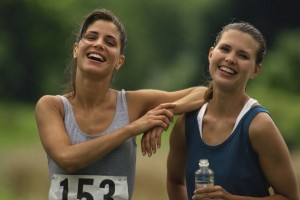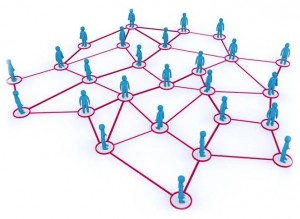Exercise is bad for your teeth? Who would have thought! Don’t know what to think but I thought this article was interesting because like the article states, vigorous exercise is good for almost all of the body — except perhaps the teeth, according to a surprising new study of athletes. Take a look at this article that shows the study published in the Scandinavian Journal of Medicine and Science in Sports.
Monthly Archives: September 2014
Blogs ‘R’ Us
Here is a few of my colleagues pages, and me talking about how great these people are!
Kenton gets straight to the point about the 80/20 rule. He says that nodes in a network can have varying number of links to and from it. He points out that a trend will often occur, which is then represented in a bell curve, however Kenton still doesn’t know how this is useful.
Kiralee covers points from the symposium however talks about how it was disengaging, and I tend to agree. However saying that, she goes on to discuss the transit system in Melbourne that Elliot covers, relating to connections. She states that connections are not always so straight forward.
Nethaniel uses a photo from his traveling last year to show and angle of a network, and demonstrating te connections through a variety of components that connect to a centre, which is seen as one particular node.
Beauty in the Beets
‘Beauty in the Beets’ by Martha Rose Shulman.
Whether Beetroots are roasted, steamed or raw they are great to have in salads, side dishes and mains. Beetroots have their health benefits with anthocyanins and betalains which are known for their antioxidant properties.
-You get Vitamin K and A
-Excellent source of folate, manganese , potassium and copper
-They are tasty TOO!
Once you go raw beet you can never go back! Check out this article with a range of information and recipes for this veggie.
Symposium WK 9
This symposium was all about listening to the tutors and seeing the viewpoints taken from the readings. This was interesting to see what they came up with and what they saw to be the most important points.
Cowbird- Example of Networking.
Cowbird is a public library of human experience where stories are gathered of people’s lives and shared. This website is a simple template for storytelling tools and is designed to encourage depth and creativity. Not only does this relate to Networking but also the idea of inner, social and cultural memory. Inner consists of Individual personal memory. Social is the combination of communication and social interaction, which human memory depends on. Cultural memory stems off the collective memory, where it can either go towards communicative memory or cultural. Cultural memory is historical, representing mythical and cultural time, with cultural identity From just finishing a presentation on cultural memory I can see this to be a great example of how information is stored and a way to accumulate memories. It is a way for people to share, and to post information online. Saying that it is a public library of human experience relates back to human memory. The presentation links cultural memory to networking suggesting that the internet is a way to store memories that can later be revisited.
Networking is linked to cultural memory through the way we communicate and interact within society. The Internet is the underlying factor that allows us to do so. The past and future are connected like a web that record information, allowing people to remember events that have happened or are going to happen. Because we live in a world where networking is imperative, memories will forever be triggered and stored away, but easily accessible. International Journal of Cultural Studies by Leon Tan says that we are the Information Age of Networks.

The 80/20 Rule
The 80/20 Rule. I still don’t understand the term completely, however when it is put with statistics I start to know it a bit better. I took some notes from this reading, that I thought are important and will put them up, because I’m not too sure what to say about this reading, just that there were a lot of examples and the explanations to me, were not clear enough.
To begin:
-The 80/20 Rule does not apply to everything and it would be a gross overstatement if it was inferred.
-The features that will be covered soon play a key role in understanding complex networks well.
-Webpages are connected to each other randomly.
POWER LAWS:
-Does not have a peak
-Each one is characterised by a unique exponent. An example the reading gives is “How many popular webpages are out there relative to the less popular ones?”
-Exponent is called the degree exponent.
-This reading states, “Our measurement indicated that the distribution of incoming links on Webpages followed a power law with a unique and well-defined degree exponent.
-Millions of Webpage creators work together in a way that generates a complex web that defies the random universe.
-Power laws mathematically formulate the fact that in most real networks the majority of nodes have only a few links and that these numerous tiny nodes coexist with a few big hubs, nodes with an anomalously high number of links. – This function is the reasons that keep networks from falling apart.
-Every time the 80/20 rule applies, there will be a power law behind it.
-There is no intrinsic scale in these networks.
-Power Laws formulate in mathematical terms the notion that a few large events carry most of the action.
These notes were taken from the reading ‘The Sixth Link’.
Blogs ‘R’ Us
This week in the land of my colleagues..
Brady talks about internet speed, and how moving community television to the internet is not ideal.
Kiralee goes into a detailed description about this weeks lecture. She talks about the statement ‘plots are for dead people’, and explains what Murphie and Potts identify some technologies as ‘neutral’.
Sam talks about Form vs Content on the subject of storytelling. He feels that the idea of form and content complement each other and is best demonstrated through Video Games.
Experimenting with Food
The want to be awesome cook of me came across an article talking about how Focaccia’s can be both sweet and savoury. They look SO delicious and seem to be an interesting way to eat such a food. So take off the tomatoes and add some peaches instead? Focaccia takes more time to make than pizza, but is apparently less challenging to make and it is more versatile. So I will have to practice my cooking and create this little gem and see what it tastes like.. Or I could just go buy one! Click here for more information!
My Fellow Colleagues
Another time to reflect on what everyone else has done, catching up from last week!
Stefan talks about the integration between technology and culture through technological determinism.
Kiralee talks about the idea that authors loose control over their work when they move it to an electronic platform in terms of story order.
Carli talks about how vulnerable are large infrastructure networks like the power grid of the internet to random failures or deliberate attacks and gives an article about ‘Four Ways The Internet Could Go Down’.
Rachel goes on to discuss whether or not we are becoming mindless users of technology, with multiple examples, one being The Candy Crush Saga.
And last but not least, Jamie talks about the Week 8 Reading by saying we have become accustomed to a certain level of comfort, and noticing that we are talking about electricity and the author’s last name is Watts.
Sharing is Caring
Time to review everyone else’s blog posts, I love reading what everyone has to say, and most of the time they explain things, which is a lot easier to understand.
Carli gives notes on the lecture which is always good to read to see the opinions of my fellow colleagues. One point was that technologies are not neutral although they may be geared towards a certain use over others, they can still be used for other purposes.
Rachel asks what comes first the chicken or the egg in one of her posts for the readings. She suggests that technology and change are much like this.
Jamie brings up a discussion about symposium #5 by saying that intent is getting lost more and more these days as the way we are communicating is more text based.
The Connected Age
Week 8 Reading is all about everything and everyone being connected. An example that was used was a spider’s web. We all weave around and into each other, whether it be through friends or internationally. This reading started off with electric power. This is everything for the world, it is how we live, what we depend on. It is the backbone of the economy and of civilised life. It is the most essential feature of the modern world. Electricity is everything in the world, and most people would never consider living without it. Is it that we can no longer or that the idea is too scary because without electricity how to we connect to the internet? From what we consume to what we do as a society, power is needed to function. For example in a lightening storm and the power goes out for a couple of minutes, what is the first thing you want to do, turn the lights on? Update your status on Facebook?
“The power grid is not really a single entity, but several regional networks cobbled together under the rubric of greater connectivity for the good of all”. The grid is made up of individual components that all link in together. Just like a network. The reading gave an example that I liked about it being like a football crowd. Can be orderly or it can be chaotic and confusing.
Some questions out of the reading I found influential, these being:
“How do norms and conventions evolve and sustain themselves in human societies, and how can they be upset and even replaced”
“How does individual behaviour aggregate to collective behaviour”
-It is all about interacting with each other and our surroundings. A Network is a collection of objects that connect to each other in some way. “The science of networks is lending the concept real analytical power”
Networks are continuously evolving and is a self-constituting system. There is a set of relationships between individuals, leading into the six degrees of separation. We all know someone who will know another person that will know someone else. If you think about it for long enough it becomes confusing, but makes sense that somehow we all know each other. We have connections through not only family but friends, and work colleagues also. Networking is a global interlocking pattern.



